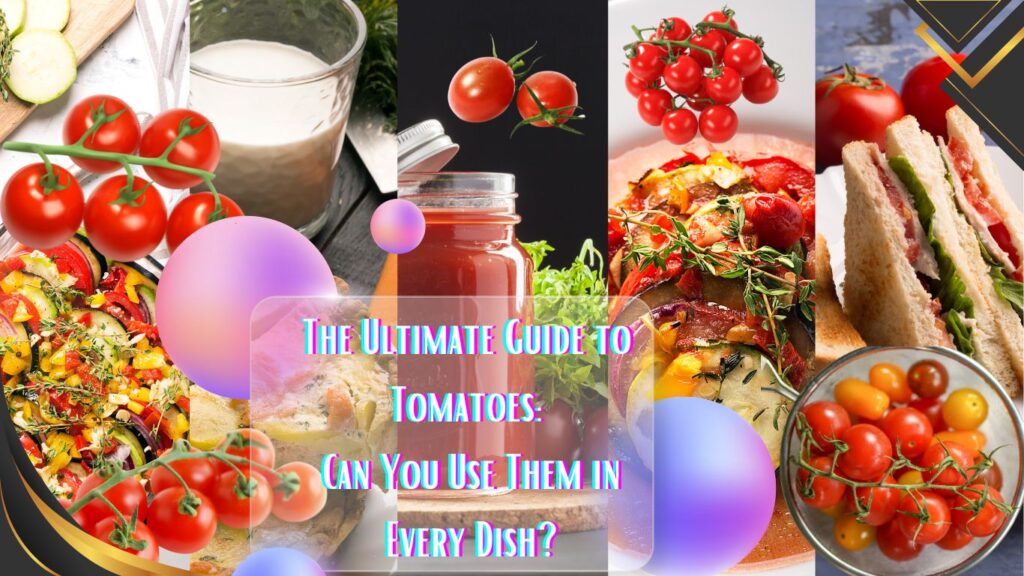We use affiliate links. If you purchase something using one of these links, we may receive compensation or commission.
Introduction: The Ubiquitous Tomato
Tomatoes are a culinary cornerstone, celebrated across cultures and cuisines for their vibrant color, tangy sweetness, and versatility. From Italian pasta sauces to Mexican salsas and Indian curries, tomatoes transcend borders. But can they truly be used in every dish? This article explores the science, history, and culinary potential of tomatoes, backed by nutritional research, chef insights, and global traditions. We’ll also address health benefits, potential drawbacks, and creative ways to incorporate tomatoes into breakfast, lunch, dinner—and even desserts.
The Nutritional Powerhouse: What’s Inside a Tomato?
Tomatoes are low in calories but rich in essential nutrients:
- Vitamins: High in vitamin C (14 mg per 100g), vitamin K, and folate (USDA).
- Antioxidants: Lycopene, a carotenoid linked to reduced risk of heart disease and cancer (NIH).
- Minerals: Potassium (237 mg per 100g), crucial for heart health.
Health Benefits:
- Heart Health: Lycopene reduces LDL cholesterol oxidation (American Heart Association).
- Skin Protection: Vitamin C boosts collagen production (Dermatology Research).
- Cancer Prevention: Studies link tomato consumption to lower prostate and stomach cancer risks (Harvard Health).
A Brief History: From Aztec Staple to Global Superfood
- Origins: Native to South America, tomatoes were domesticated by the Aztecs around 700 AD.
- Global Spread: Spanish explorers introduced them to Europe in the 16th century, where they were initially feared as poisonous.
- Cultural Integration: Italy’s love affair with tomatoes began in the 18th century, revolutionizing dishes like pizza and pasta.
Tomatoes in Every Meal: A Culinary Deep Dive
Breakfast
- Shakshuka: North African eggs poached in spiced tomato sauce.
- Tomato Jam: Sweet-savory spread for toast (recipe here).
Lunch
- Gazpacho: Chilled Spanish soup blending tomatoes, cucumbers, and olive oil.
- Caprese Salad: Fresh mozzarella, basil, and heirloom tomatoes.
Dinner
- Thai Tom Yum Soup: Tangy broth with cherry tomatoes and lemongrass.
- Indian Butter Chicken: Creamy tomato-based curry.
Dessert
- Tomato Sorbet: A refreshing, unexpected treat (recipe here).
- Tomato-Infused Chocolate: Dark chocolate with sun-dried tomato flakes.
Chef Tip: Use tomato water (strained pulp) in cocktails or dressings for a subtle umami kick.
Health Considerations: When to Moderate Tomato Intake
While tomatoes are nutritious, certain conditions warrant caution:
- Acid Reflux: High acidity may aggravate GERD (Mayo Clinic).
- Nightshade Sensitivity: Rare allergies to solanine in tomatoes.
- Kidney Stones: Oxalate content may contribute to stone formation in susceptible individuals (National Kidney Foundation).
Tip: Cooking tomatoes reduces acidity and enhances lycopene absorption.
Debunking Myths: Can Tomatoes Truly Go in Every Dish?
- Myth 1: “Tomatoes ruin delicate desserts.”
- Reality: When balanced with sweetness (e.g., tomato tarte tatin), they shine.
- Myth 2: “Raw tomatoes are healthier than cooked.”
- Reality: Cooking boosts lycopene bioavailability (Journal of Agricultural and Food Chemistry).
Exceptions:
- Traditional Dishes: Some Asian desserts (e.g., mango sticky rice) lack tomato synergy.
- Allergies: Avoidance is necessary for sensitive individuals.
Sustainable Tomato Use: Reducing Waste
- Preservation: Freeze pureed tomatoes or dry them into powder.
- Composting: Use scraps for garden fertilizer.
- Zero-Waste Recipes: Tomato leaf pesto, pickled green tomatoes.
The Future of Tomatoes: Innovation in Agriculture
- Vertical Farming: Hydroponic tomatoes in urban settings.
- Biofortification: Enhancing lycopene content through gene editing (Nature Journal).
Conclusion: Embrace the Tomato Revolution
Tomatoes are not just an ingredient—they’re a cultural bridge, a nutritional gem, and a canvas for creativity. While they might not suit every dish universally, their adaptability is unmatched. Whether you’re blending them into smoothies or fermenting them into kimchi, tomatoes invite experimentation.
Final Tip: Grow your own heirloom varieties for peak flavor and sustainability.
Sources:


